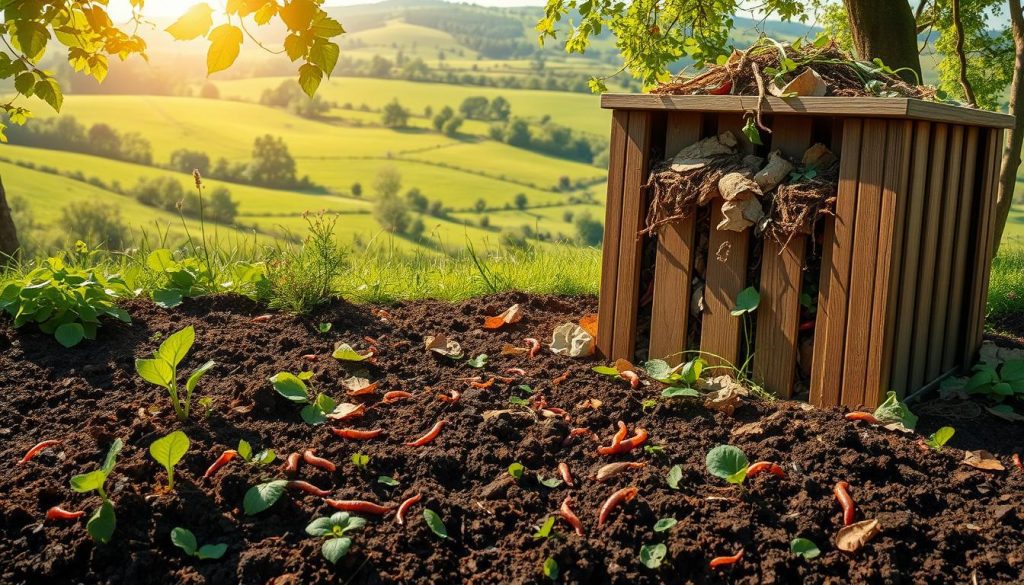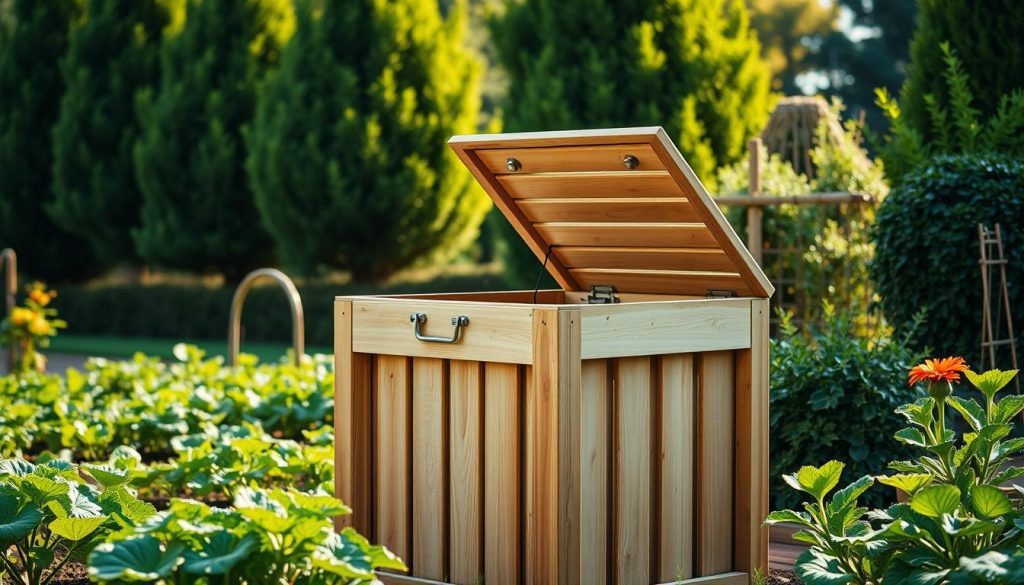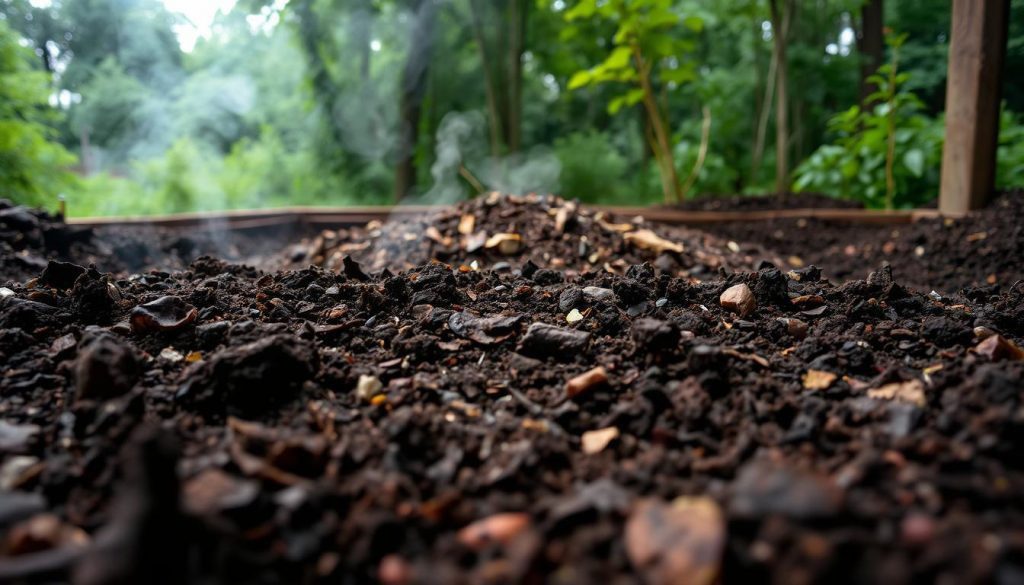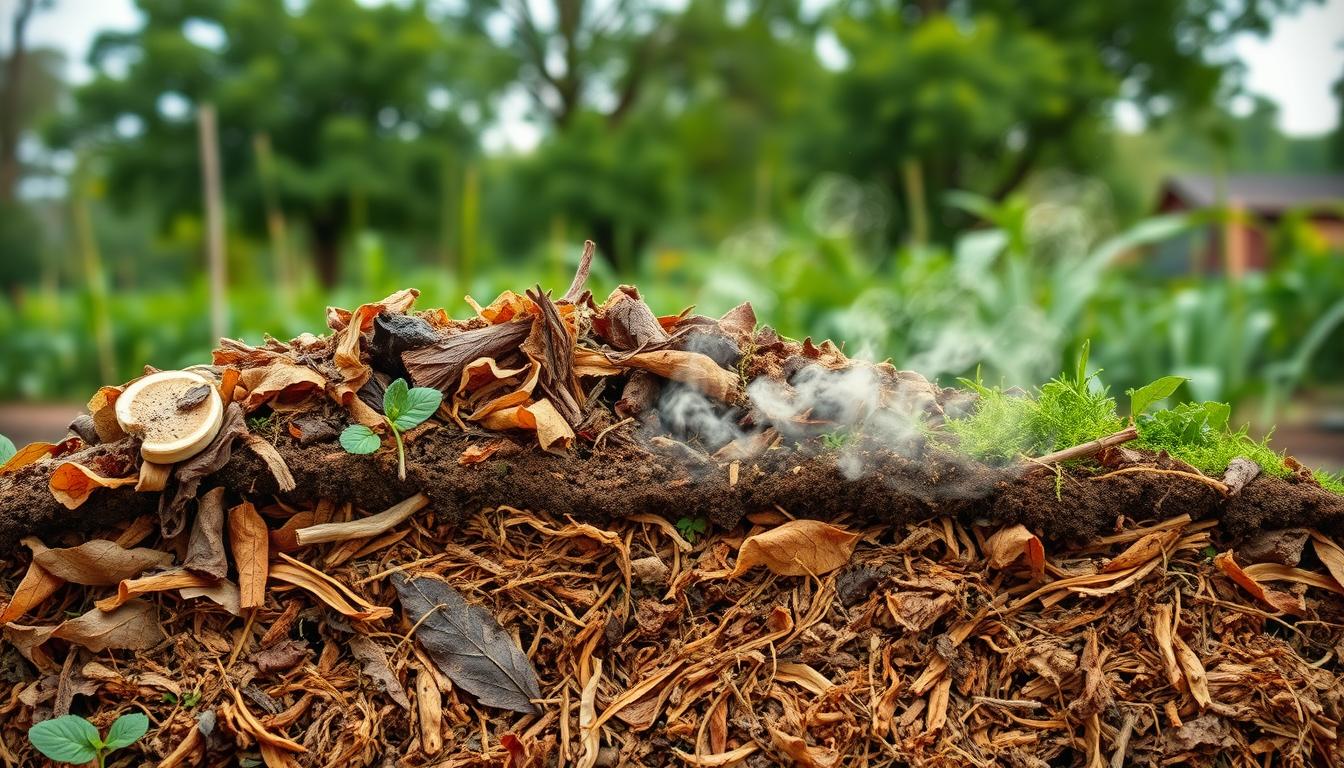As a gardener, I’ve often wondered about the necessity of turning compost. Many gardeners compost their garden waste, but quite a few don’t make the regular effort to turn their compost.
Composting is a process where microorganisms break down plant matter and other biodegradable materials into a dark, crumbly, decomposed organic matter.
Composting is an essential practice for gardeners, as it provides a nutrient-rich soil amendment that improves soil structure and fertility.
By understanding the importance of compost maintenance, gardeners can optimize their composting process.

Key Takeaways
- Composting is a natural process that breaks down organic materials.
- Microorganisms play a crucial role in decomposing plant matter.
- Regular compost turning is essential for optimal decomposition.
- Compost maintenance is vital for gardeners to optimize their composting process.
- Composting improves soil structure and fertility.
The Traditional Composting Wisdom
For a long time, people have believed that compost needs to be turned often. This idea comes from knowing that turning helps keep the compost aerobic.
This is key for the decomposition process to work well.
Turning compost is more than just mixing it up. It’s about making a space where aerobic decomposition can happen. By turning, we add oxygen.
This oxygen is vital for the tiny organisms that break down the compost.
Why We’re Told to Turn Compost Regularly
Turning compost regularly is mainly to keep it aerated. If a compost pile isn’t turned, the outside might not get enough oxygen.
This slows down how fast it breaks down. Turning it ensures that all parts get a chance to decompose well.
Also, turning compost:
- Makes decomposition faster
- Reduces bad smells by adding oxygen
- Stops anaerobic conditions from forming
The Science Behind Turning Recommendations
The science behind turning compost is linked to the composting process. The tiny life forms that break down compost need oxygen to work well. Turning the compost gives them the oxygen they need, helping the decomposition process.
The table below shows how turning compost affects different things:
| Factor | Effect of Turning | Impact on Composting |
|---|---|---|
| Aeration | Increased oxygen flow | Enhanced microbial activity |
| Material Mixing | Better distribution of materials | Faster decomposition |
| Temperature Regulation | More uniform temperature distribution | Optimal conditions for microorganisms |
What Happens If You Don’t Turn Compost?
Compost that isn’t turned changes in both physical and biological ways. When a compost pile sits without being turned, decomposition keeps going.
But it happens at a slower pace and in different ways than turned compost.
The Physical Changes in Untouched Compost
In untouched compost piles, the bottom material breaks down first. This is because the bottom layers are more compact and have different moisture levels than the top.
As time goes on, decomposition moves up, affecting the top layers too.
The compost’s structure also changes. Without turning, the pile can get compacted, which might lead to anaerobic conditions. But decomposition still happens, just at a slower rate.
| Layer | Decomposition Rate | Characteristics |
|---|---|---|
| Bottom | Fast | Compact, moist |
| Middle | Moderate | Variable moisture, some compaction |
| Top | Slow | Drier, less compact |
The Biological Process Differences
The biological processes in untouched compost are quite different from turned compost. Microorganisms still break down organic matter, but the types and numbers can vary.
In unturned compost, anaerobic conditions can develop. This favors anaerobic microorganisms.
It can lead to unpleasant odors as by-products of decomposition.
Even so, the end result of composting is still valuable. It’s a nutrient-rich, humus-rich resource for gardening and agriculture, as long as composting is managed right.
The Slower Decomposition Reality
Composting without turning is slower, but it can still work well. Without turning, the compost breaks down more slowly.
This is because microbes and worms need oxygen and mixing to work efficiently.
How Decomposition Rate Changes
Not turning compost means it breaks down slower. This is because there’s less oxygen and mixing. So, the organic matter breaks down more slowly, often becoming more humus-like.
Several factors affect how slow decomposition is in unturned compost. These include:
- Moisture levels: Too dry or too wet can slow it down a lot.
- Carbon-to-nitrogen ratio: A good mix of “green” and “brown” materials is key.
- Presence of decomposers: Having many microbes, bugs, and worms is important.
Timeline Comparisons: Turned vs. Untouched Compost
Composting times vary a lot, depending on whether you turn the pile or not. Turned compost is ready in 6-8 weeks.
But unturned compost can take months to a year or more.
Here’s a quick look at the times:
| Compost Type | Typical Completion Time |
|---|---|
| Turned Compost | 6-8 weeks |
| Unturned Compost | Several months to 1 year or more |
Even though unturned compost takes longer, it’s still worth the wait. It can become a valuable soil amendment.
Potential Problems with Unturned Compost
Not turning compost can lead to several issues, like anaerobic conditions and pest problems.
While it might seem easier not to turn compost, it’s important to know the downsides.
Anaerobic Conditions and Odor Issues
Compost that’s not turned often becomes compacted. This creates anaerobic conditions where bad-smelling microbes grow.
To avoid this, make sure the compost pile gets enough air. Adding materials like straw or perlite can help.
Temperature Regulation Challenges
Unturned compost piles can struggle to keep a steady temperature. They can get very hot, sometimes over 160°F. But, without turning, the heat doesn’t spread evenly.
This can slow down the composting and let weed seeds survive.
Pest Attraction Concerns
Unturned compost also attracts pests like rodents and flies. This happens if the compost pile isn’t kept clean. To avoid pests, make sure the compost is balanced and food scraps are fully covered.
Knowing these issues helps composters manage their piles better, even if they don’t turn them.
Regular checks and upkeep keep composting efficient and effective.
Surprising Benefits of Not Turning Compost
As a lazy gardener, I’ve found that not turning compost can be good. It makes composting easier and saves time.
This method might not be common, but it works well.
Energy and Time Conservation
Not turning compost saves a lot of energy and time. Composting without turning means no need for constant turning.
This is great for those with little time or mobility. It saves up to 5 hours of work, which you can use for other gardening tasks.
Natural Habitat Creation
Not turning compost helps create a home for worms and microorganisms. These creatures are key in breaking down organic matter. By not disturbing them, we help them thrive.
This supports biodiversity and promotes a healthy composting process.
Different But Valuable End Product
The compost from not turning might look different, but it’s still full of nutrients. It might be more broken down and have a unique texture.
Yet, it’s still rich in nutrients. Not turning compost can even lead to a more diverse microbial community.
| Characteristics | Turned Compost | Unturned Compost |
|---|---|---|
| Decomposition Rate | Faster | Slower |
| Microbial Diversity | Less diverse | More diverse |
| Labor Required | High | Low |
In summary, not turning compost has many benefits. It saves energy and time, creates a natural habitat, and produces a valuable end product.
This low-maintenance approach helps gardeners achieve great results with less effort.
Environmental Impact Comparison
Composting methods have big environmental effects for gardeners and eco-advocates. Looking at turned and unturned compost shows each has its own environmental mark.
One key issue is the carbon footprint. Unturned compost piles have a smaller carbon footprint because they need less work and energy.
On the other hand, turned compost needs more effort, which can increase emissions.
Carbon Footprint Differences
The carbon footprint of composting changes with how often it’s turned. Unturned compost cuts down on the need for machines or manual work, lowering emissions.
A study showed unturned composting can cut greenhouse gas emissions by up to 50% compared to turned composting.
- Lower energy input
- Reduced greenhouse gas emissions
- Less reliance on machinery
Biodiversity Support in Unturned Piles
Unturned compost piles are homes for many organisms, boosting biodiversity. The calm environment lets microorganisms and insects grow, making the ecosystem healthier.
As Dr. Elaine Ingham, a soil microbiologist, says, “A diverse soil ecosystem is key for soil health and fertility.”
Choosing unturned composting helps gardeners lessen their environmental impact. It also supports biodiversity in their gardens.
My Experience with No-Turn Composting
I’ve learned a lot about no-turn composting through trial and error. At first, I doubted its effectiveness. But now, I see its many benefits.
No-turn composting lets organic materials break down without turning the pile.
This is different from traditional composting, where turning is key to speed up the process and avoid bad smells.
Successes and Failures in My Garden
My journey with no-turn composting has had ups and downs. One big win was making compost in under a month. I kept the right mix of materials and made sure it was moist enough.
But, I’ve also faced issues like bad smells from anaerobic conditions.
- Some of the key successes include:
- Reduced labor, as I don’t need to regularly turn the compost pile.
- Creation of a more natural habitat for beneficial microorganisms.
- A different, but valuable end product that’s rich in nutrients.
What I’ve Learned Over the Years
Through experience, I’ve picked up some important lessons. First, keeping an eye on moisture levels is key. Too dry or too wet can cause problems. Also, layering materials correctly at the start helps a lot.
Some key takeaways include:
- The importance of balancing carbon-rich and nitrogen-rich materials.
- The need to be patient, as decomposition takes longer without turning.
- The value of using the resulting compost as a nutrient-rich mulch.
Alternative Low-Maintenance Composting Methods
If you want to make composting easier, there are simpler ways to do it. These methods need less time and effort. They make composting more accessible to everyone.
Cold Composting Approach
Cold composting lets organic matter break down slowly without turning. It uses microorganisms to decompose materials.
This method is slower than hot composting but is less labor-intensive. It still makes a nutrient-rich compost.
Trench Composting
Trench composting involves burying organic waste in garden trenches. As it decomposes, it improves soil structure and fertility.
It’s great for gardeners who compost where the nutrients are needed most.
Vermicomposting Without Turning
Vermicomposting, or worm composting, is another easy method. It uses worms to break down organic matter.
To keep it without turning, layer materials correctly and ensure moisture and air. It’s perfect for indoor composting and recycling kitchen waste.
These low-maintenance composting methods give gardeners more options. By picking the right one, you can reduce your environmental impact and still enjoy composting.
- Cold composting: Decomposing organic matter over a longer period without turning.
- Trench composting: Burying organic waste directly in garden trenches.
- Vermicomposting: Using worms to break down organic matter without regular turning.
Designing a Compost System That Requires Minimal Turning
Gardeners can make a compost system that needs little care. This method cuts down on the hard work of composting. It also uses nature’s ways to make great compost.
When making a compost system that needs little turning, think about how you start and what materials you use. For example, a Speedibin should be filled at least ¾ full at first.
This helps create a good place for decomposition without needing to turn it often.
Optimal Bin Design Considerations
A well-made compost bin is key for less turning. It needs good air for decomposition to work well. Good aeration comes from vents or bin designs that let air in.
Also, the bin should be the right size for the composting material; too small or too big can be a problem.

Think about how easy it is to get to the bin. Easy access makes adding materials and checking the compost easier. Some bins have doors or slats for easier turning when needed.
Material Selection and Layering Techniques
The materials you choose affect how often you need to turn the pile. A mix of “green” (like kitchen scraps) and “brown” (like dried leaves) materials is best. Layering these materials well helps break them down faster and keeps smells down.
Start with coarse materials at the bottom for better air. Then, layer materials rich in carbon and nitrogen. This balance helps the composting process work well with little help.
With the right design and materials, gardeners can enjoy composting with less work.
Tools and Equipment for No-Turn Composting
No-turn composting is easy and doesn’t cost much. You don’t need special tools.
You can start composting with what you already have. This makes it simple and affordable.
What You Need (and Don’t Need)
For no-turn composting, you only need a few things. A container or bin is essential. You can use a wire mesh or a wooden pallet box. Some people even use a large trash can.
It’s important to have something that lets air in. It should also hold all the materials you plan to compost.
| Tool/Equipment | Necessity | Notes |
|---|---|---|
| Compost Bin | High | Can be as simple as a wire mesh or wooden pallet enclosure |
| Garden Fork | Low | Useful for occasional checks, but not necessary for no-turn composting |
| Compost Tumbler | Low | Not necessary for no-turn composting; more suited for regular turning |
Money-Saving Benefits
No-turn composting is also very cost-effective. You don’t need to buy expensive equipment like compost tumblers.
The simplicity of no-turn composting means you can start composting without spending a lot. It’s perfect for gardeners who are on a budget.
Troubleshooting Common Issues
No-turn composting, like any other method, needs troubleshooting to solve common problems. Issues like slow decomposition and moisture imbalances can happen. Knowing how to fix these problems is key to success.
Dealing with Slow Decomposition
Slow decomposition is a common issue in no-turn composting. To fix this, make sure your compost pile has the right mix of ‘green’ and ‘brown’ materials. Insufficient nitrogen can slow down decomposition. Adding more green materials like kitchen scraps or grass clippings can help.
Also, checking the moisture level is crucial. Both too dry and too wet conditions can slow down decomposition.
A quote from a renowned composting expert highlights the importance of balance:
“The key to successful composting lies in creating an environment that supports the microorganisms’ needs, including the right mix of materials and adequate moisture.”
Managing Moisture Problems
Moisture issues are common in no-turn composting. The compost should be like a damp sponge. If it’s too dry, decomposition slows down. Too much moisture can cause anaerobic conditions and bad odors.
To manage moisture, regular checks are necessary. Adding dry materials like straw or shredded newspaper can absorb excess moisture. Adding water or wet materials can help if it’s too dry.
| Issue | Symptoms | Solution |
|---|---|---|
| Slow Decomposition | Little change in material over time | Add more green materials, check moisture |
| Excessive Moisture | Anaerobic conditions, bad odors | Add dry materials like straw or newspaper |
| Dryness | Slow decomposition, dry feel | Add water or wet materials |
When You Should Still Consider Turning
Not turning compost can be good, but sometimes you need to step in. It’s important to know when to let it go and when to help.
Some situations need your attention to keep composting healthy. For example, hot compost needs air to keep bugs happy. This is crucial with lots of green stuff that can get too wet.
Specific Situations That Benefit from Intervention
There are times when turning your compost is a good idea:
- When the pile is too tight, turning helps air get in and keeps it from getting too wet.
- Adding lots of green stuff at once? Turning helps spread it out.
- Too dry or too wet? Turning can fix the moisture.

Minimal Turning Strategies
If you do turn your compost, do it right. Here’s how:
- Turn only when necessary: Don’t turn too much, it messes things up.
- Use the right tools: A compost turner or pitchfork is best to avoid damage.
- Monitor the pile’s condition: Check moisture, temperature, and condition to see if turning is needed.
Knowing when to help in the composting process makes your compost better. It leads to a healthier end product.
To summarize
Compost requires regular turning to maintain an optimal environment for decomposition, and neglecting this step can significantly hinder the process.
Without turning, compost piles become anaerobic, slowing microbial activity as oxygen levels drop.
Aerobic microbes, which thrive in oxygen-rich conditions and efficiently break down organic matter, are replaced by slower anaerobic bacteria.
This leads to a sluggish decomposition process, often taking months longer to produce usable compost.
Unturned compost also risks developing foul odors. Anaerobic conditions produce methane, hydrogen sulfide, and other smelly gases, creating a stench like rotten eggs or garbage.
These odors can attract pests such as rodents or flies, further complicating the composting effort. Additionally, the lack of aeration causes uneven decomposition.
The pile’s core may become overly compacted, forming dense, wet clumps that resist breaking down, while outer layers remain dry and undecomposed.
Nutrient balance suffers as well. Turning mixes carbon-rich “browns” (like leaves) with nitrogen-rich “greens” (like food scraps), ensuring microbes have a balanced diet.
Without it, pockets of imbalanced materials form, reducing compost quality.
Pathogens and weed seeds may also survive in unturned piles, as the lack of consistent heat from proper aeration prevents the high temperatures (130-160°F) needed to kill them.
Finally, unturned compost can become waterlogged or overly dry, depending on climate, further stalling decomposition.
Regular turning—every 3-7 days—ensures a faster, smell-free process, yielding rich, crumbly compost for gardening. Neglect ultimately delays results and diminishes the compost’s value. (250 words)
Conclusion
Deciding whether to turn compost depends on several things. These include the composting method, the materials used, and your personal preference.
Knowing what happens if you don’t turn compost is key to choosing the right approach for your garden.
Low-maintenance composting methods like cold composting and vermicomposting are good alternatives. They save you from the hard work of turning compost.
Plus, they help save energy and create natural habitats.
By picking a composting method that fits your lifestyle, you can get rich soil, cut down on waste, and garden more sustainably.
Whether you turn your compost or not, the most important thing is to find a method that works for you.
This way, you can enjoy composting’s benefits without too much effort.





